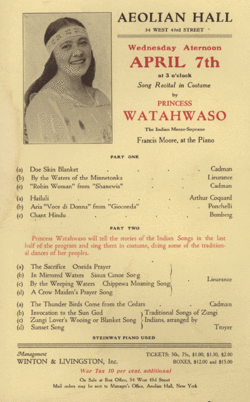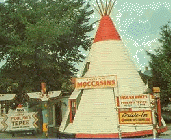She started performing around that time in productions to promote Maine tourism. She was noticed by Harvard administrator Montague Chamberlain, who became her patron and took her to Boston and New York for musical events. In 1905, she married a Boston doctor and moved to Washington, DC. They divorced in 1913 and she moved to Chicago to study piano at a music conservatory, the Music School of Chautaugua. She then married Tom Gorman, a lawyer, who became her manager. Her first public performance was in 1916. A mezzo-soprano, she became a recording artist at that point with Victor Artists. Her performances generally included Indianist and Native American pieces and opera arias.
In 1917, she joined the Redpath Chautaugua Bureau and traveled with them until 1919. During the 1920's, she traveled with the Keith Vaudeville Circuit, where she met fellow performer Chief Bruce Poolaw. When the stock market crashed in 1929, her husband Tom Gorman abandoned her and went to Mexico. She returned to her home on the Penobscot Reservation on Indian Island and some years later, Chief Bruce Poolaw joined her there. They married and settled down on Indian Island, where they built their home. She and her sister Florence worked tirelessly to improve educational opportunities for the Indian children and to seek the right for Indians on reservations to vote. She and Chief Poolaw continued to perform in local venues and in 1947, she had a 24 foot diameter tepee built next to their home. They used it as a gift store and tourist attraction, which they operated until her death in 1969.
She started performing around that time in productions to promote Maine tourism. She was noticed by Harvard administrator Montague Chamberlain, who became her patron and took her to Boston and New York for musical events. In 1905, she married a Boston doctor and moved to Washington, DC. They divorced in 1913 and she moved to Chicago to study piano at a music conservatory, the Music School of Chautaugua. She then married Tom Gorman, a lawyer, who became her manager. Her first public performance was in 1916. A mezzo-soprano, she became a recording artist at that point with Victor Artists. Her performances generally included Indianist and Native American pieces and opera arias.
In 1917, she joined the Redpath Chautaugua Bureau and traveled with them until 1919. During the 1920's, she traveled with the Keith Vaudeville Circuit, where she met fellow performer Chief Bruce Poolaw. When the stock market crashed in 1929, her husband Tom Gorman abandoned her and went to Mexico. She returned to her home on the Penobscot Reservation on Indian Island and some years later, Chief Bruce Poolaw joined her there. They married and settled down on Indian Island, where they built their home. She and her sister Florence worked tirelessly to improve educational opportunities for the Indian children and to seek the right for Indians on reservations to vote. She and Chief Poolaw continued to perform in local venues and in 1947, she had a 24 foot diameter tepee built next to their home. They used it as a gift store and tourist attraction, which they operated until her death in 1969.
Family Members
Sponsored by Ancestry
Advertisement
Advertisement













